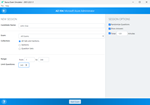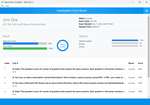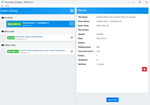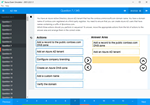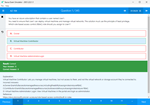Download Provisioning SQL Databases.70-765.PracticeTest.2019-02-01.107q.tqb
| Vendor: | Microsoft |
| Exam Code: | 70-765 |
| Exam Name: | Provisioning SQL Databases |
| Date: | Feb 01, 2019 |
| File Size: | 3 MB |
How to open TQB files?
Files with TQB (Taurus Question Bank) extension can be opened by Taurus Exam Studio.
Purchase
Coupon: TAURUSSIM_20OFF
Discount: 20%
Demo Questions
Question 1
You administer all the deployments of Microsoft SQL Server 2012 in your company. You have two servers in the same data center that hosts your production database.
You need to ensure that the database remains available if a catastrophic server failure or a disk failure occurs.
You also need to maintain transactional consistency of the data across both servers.
You need to achieve these goals without manual intervention.
Which configuration should you use?
- Two servers configured in a Windows Failover Cluster in the same data center SQL Server configured as a clustered instance
- SQL Server that includes an application database configured to perform transactional replication
- Two servers configured in the same data centerA primary server configured to perform log-shipping every 10 minutes A backup server configured as a warm standby
- Two servers configured in different data centersSQL Server Availability Group configured in Synchronous-Commit Availability Mode One server configured as an Active Secondary
- Two servers configured in the same data centerSQL Server Availability Group configured in Asynchronous-Commit Availability Mode One server configured as an Active Secondary
- Two servers configured in different data centersSQL Server Availability Group configured in Asynchronous-Commit Availability Mode
- SQL Server that includes an application database configured to perform snapshot replication
- Two servers configured on the same subnetSQL Server Availability Group configured in Synchronous-Commit Availability Mode
Correct answer: H
Explanation:
Always On availability groups supports two availability modes—asynchronous-commit mode and synchronous-commit mode Synchronous-commit mode emphasizes high availability over performance, at the cost of increased transaction latency. References: https://docs.microsoft.com/en-us/sql/database-engine/availability-groups/windows/availability-modes-always-on-availability-groups#SyncCommitAvMode Always On availability groups supports two availability modes—asynchronous-commit mode and synchronous-commit mode
Synchronous-commit mode emphasizes high availability over performance, at the cost of increased transaction latency.
References: https://docs.microsoft.com/en-us/sql/database-engine/availability-groups/windows/availability-modes-always-on-availability-groups#SyncCommitAvMode
Question 2
You create an availability group that has replicas named HA/Server01 and HA/Server02.
Currently, HA/Server01 is the primary replica.
You have multiple queries that read data and produce reports from the database.
You need to offload the reporting workload to the secondary replica when HA/Server01 is the primary replica.
What should you do?
- Set the Availability Mode property of HA/Server02 to Asynchronous commit.
- Set the Readable Secondary property of HA/Server02 to Read-intent only.
- Set the Connections in Primary Role property of HA/Server01 to Allow read/write connections.
- Set the Availability Mode property of HA/Server01 to Asynchronous commit.
Correct answer: B
Explanation:
To set up a readable secondary replica, you first create an availability group. Then you add replicas. You can choose either Yes or Read-intent only options. References: http://msdn.microsoft.com/en-us/library/jj542414.aspx To set up a readable secondary replica, you first create an availability group. Then you add replicas.
You can choose either Yes or Read-intent only options.

References: http://msdn.microsoft.com/en-us/library/jj542414.aspx
Question 3
You administer a Microsoft SQL Server 2012 database instance.
You plan to migrate the database to Windows Azure SQL Database. You verify that all objects contained in the database are compatible with Windows Azure SQL Database.
You need to ensure that database users and required server logins are migrated to Windows Azure SQL Database.
What should you do?
- Use the copy database wizard
- Use the Database Transfer wizard
- Use SQL Server Management Studio to deploy the database to Windows Azure SQL Database
- Backup the database from the local server and restore it to Windows Azure SQL Database
Correct answer: C
Explanation:
You would need to use either the SQL Server Management Studio or Transact-SQL. References: https://docs.microsoft.com/en-us/azure/sql-database/sql-database-cloud-migrate You would need to use either the SQL Server Management Studio or Transact-SQL.
References: https://docs.microsoft.com/en-us/azure/sql-database/sql-database-cloud-migrate
Question 4
You administer a Microsoft SQL Server 2012 environment. One of the SQL Server 2012 instances contains a database named Sales.
You plan to migrate Sales to Windows Azure SQL Database.
To do so, you need to implement a contained database.
What should you do? (Each correct answer presents part of the solution. Choose all that apply.)
- Set database containment to AZURE.
- Enable server property contained database authentication.
- Disable server property cross db ownership chaining.
- Set database containment to PARTIAL.
- Disable server property contained database authentication.
- Set database containment to FULL.
Correct answer: BD
Explanation:
A contained database is a database that is isolated from other databases and from the instance of SQL Server that hosts the database. B: In the contained database user model, the login in the master database is not present. Instead, the authentication process occurs at the user database, and the database user in the user database does not have an associated login in the master database.SQL Database and SQL Data Warehouse support Azure Active Directory identities as contained database users. D: The contained database feature is currently available only in a partially contained state. A partially contained database is a contained database that allows the use of uncontained features.References: https://docs.microsoft.com/en-us/sql/relational-databases/databases/contained-databases A contained database is a database that is isolated from other databases and from the instance of SQL Server that hosts the database.
B: In the contained database user model, the login in the master database is not present. Instead, the authentication process occurs at the user database, and the database user in the user database does not have an associated login in the master database.
SQL Database and SQL Data Warehouse support Azure Active Directory identities as contained database users.
D: The contained database feature is currently available only in a partially contained state. A partially contained database is a contained database that allows the use of uncontained features.
References: https://docs.microsoft.com/en-us/sql/relational-databases/databases/contained-databases
Question 5
You plan to install Microsoft SQL Server 2012 for a web hosting company.
The company plans to host multiple web sites, each supported by a SQL Server database.
You need to select an edition of SQL Server that features backup compression of databases, basic data integration features, and low total cost of ownership.
Which edition should you choose?
- Express Edition with Tools
- Standard Edition
- Web Edition
- Express Edition with Advanced Services
Correct answer: B
Explanation:
Incorrect Answers:A, D: Express edition has severe limitations.C: SQL Server 2012 Web edition is a low total-cost-of-ownership option for Web hosters and Web VAPs to provide scalability, affordability, and manageability capabilities for small to large scale Web properties.References: https://msdn.microsoft.com/en-us/library/ms144275(v=sql.110).aspx Incorrect Answers:
A, D: Express edition has severe limitations.
C: SQL Server 2012 Web edition is a low total-cost-of-ownership option for Web hosters and Web VAPs to provide scalability, affordability, and manageability capabilities for small to large scale Web properties.
References: https://msdn.microsoft.com/en-us/library/ms144275(v=sql.110).aspx
Question 6
You use Microsoft Azure Resource Manager to deploy two new Microsoft SQL Server instances in an Azure virtual machine (VM). VM has 28 gigabytes (GB) of memory. The instances are named Instance1 and Instance2, respectively.
The various databases on the instances have the following characteristics:

You run the following Transact-SQL statements:

You need to configure each SQL Server instance to correctly allocate memory.
What should you do?
- On Instance1, run the following Transact-SQL code:
 On Instance2, run the following Transact-SQL code:
On Instance2, run the following Transact-SQL code:
- A. On Instance1, run the following Transact-SQL code:
 On Instance2, run the following Transact-SQL code:
On Instance2, run the following Transact-SQL code:
- On Instance1, run the following Transact-SQL code:
 On Instance2, run the following Transact-SQL code:
On Instance2, run the following Transact-SQL code:
- On Instance1, run the following Transact-SQL code:
 On Instance2, run the following Transact-SQL code:
On Instance2, run the following Transact-SQL code:
Correct answer: D
Explanation:
Incorrect Answers:A, C: The awefeature will be removed in newer version of Microsoft SQL Server. Do not use this feature in new development work, and modify applications that currently use this feature as soon as possible.B: Automatic soft-NUMA is disabled by default, and this setting is not relevant here.References: https://docs.microsoft.com/en-us/sql/database-engine/configure-windows/server-configuration-options-sql-server Incorrect Answers:
A, C: The awefeature will be removed in newer version of Microsoft SQL Server. Do not use this feature in new development work, and modify applications that currently use this feature as soon as possible.
B: Automatic soft-NUMA is disabled by default, and this setting is not relevant here.
References: https://docs.microsoft.com/en-us/sql/database-engine/configure-windows/server-configuration-options-sql-server
Question 7
You manage a Microsoft SQL Server environment in a Microsoft Azure virtual machine.
You must enable Always Encrypted for columns in a database.
You need to configure the key store provider.
What should you do?
- Use the Randomized encryption type
- Modify the connection string for applications.
- Auto-generate a column master key.
- Use the Azure Key Vault.
Correct answer: D
Explanation:
There are two high-level categories of key stores to consider - Local Key Stores, and Centralized Key Stores. Centralized Key Stores - serve applications on multiple computers. An example of a centralized key store is Azure Key Vault. Local Key Stores References: https://docs.microsoft.com/en-us/sql/relational-databases/security/encryption/create-and-store-column-master-keys-always-encrypted There are two high-level categories of key stores to consider - Local Key Stores, and Centralized Key Stores.
- Centralized Key Stores - serve applications on multiple computers. An example of a centralized key store is Azure Key Vault.
- Local Key Stores
References: https://docs.microsoft.com/en-us/sql/relational-databases/security/encryption/create-and-store-column-master-keys-always-encrypted
Question 8
Note: This question is part of a series of questions that use the same or similar answer choices. An answer choice may be correct for more than one question in the series. Each question is independent of the other questions in this series. Information and details provided in a question apply only to that question.
You have deployed several GS-series virtual machines (VMs) in Microsoft Azure. You plan to deploy Microsoft SQL Server in an Always On Availability Group. You expect to have less than 1 million IO transaction per month.
You need to recommend a storage solution for the SQL Servers. The solution must minimize costs.
Which storage option should you use?
- Premium P10 disk storage
- Premium P20 disk storage
- Premium P30 disk storage
- Standard locally redundant disk storage
- Standard geo-redundant disk storage
- Standard zone redundant blob storage
- Standard locally redundant blob storage
- Standard geo-redundant blob storage
Correct answer: A
Explanation:
P10 has 500 IOPS per disk, which provides for more than 1 million IOPS per month. Note: 3600*30* 500 is 54 million IOPS/month.References: https://azure.microsoft.com/en-us/pricing/details/managed-disks/ P10 has 500 IOPS per disk, which provides for more than 1 million IOPS per month.
Note: 3600*30* 500 is 54 million IOPS/month.
References: https://azure.microsoft.com/en-us/pricing/details/managed-disks/
Question 9
You create a new Microsoft Azure subscription.
You need to create a group of Azure SQL databases that share resources.
Which cmdlet should you run first?
- New-AzureRmAvailabilitySet
- New-AzureRmLoadBalancer
- New-AzureRmSqlDatabaseSecondary
- New-AzureRmSqlElasticPool
- New-AzureRmVM
- New-AzureRmSqlServer
- New-AzureRmSqlDatabaseCopy
- New-AzureRmSqlServerCommunicationLink
Correct answer: D
Explanation:
SQL Database elastic pools are a simple, cost-effective solution for managing and scaling multiple databases that have varying and unpredictable usage demands. The databases in an elastic pool are on a single Azure SQL Database server and share a set number of resources (elastic Database Transaction Units (eDTUs)) at a set price. Elastic pools in Azure SQL Database enable SaaS developers to optimize the price performance for a group of databases within a prescribed budget while delivering performance elasticity for each database. References: https://docs.microsoft.com/en-us/azure/sql-database/sql-database-elastic-pool SQL Database elastic pools are a simple, cost-effective solution for managing and scaling multiple databases that have varying and unpredictable usage demands. The databases in an elastic pool are on a single Azure SQL Database server and share a set number of resources (elastic Database Transaction Units (eDTUs)) at a set price. Elastic pools in Azure SQL Database enable SaaS developers to optimize the price performance for a group of databases within a prescribed budget while delivering performance elasticity for each database.
References: https://docs.microsoft.com/en-us/azure/sql-database/sql-database-elastic-pool
Question 10
You have a Microsoft Azure SQL database in the US West region.
You need to create a replica in the US East region.
Which cmdlet should you run first?
- New-AzureRmAvailabilitySet
- New-AzureRmLoadBalancer
- New-AzureRmSqlDatabaseSecondary
- New-AzureRmSqlElasticPool
- New-AzureRmVM
- New-AzureRmSqlServer
- New-AzureRmSqlDatabaseCopy
- New-AzureRmSqlServerCommunicationLink
Correct answer: G
Explanation:
The New-AzureRmSqlDatabaseCopy command creates a copy of a SQL Database that uses the snapshot at the current time. References: https://docs.microsoft.com/en-us/powershell/module/azurerm.sql/new-azurermsqldatabasecopy?view=azurermps-5.1.1 The New-AzureRmSqlDatabaseCopy command creates a copy of a SQL Database that uses the snapshot at the current time.
References: https://docs.microsoft.com/en-us/powershell/module/azurerm.sql/new-azurermsqldatabasecopy?view=azurermps-5.1.1
HOW TO OPEN VCE FILES
Use VCE Exam Simulator to open VCE files

HOW TO OPEN VCEX FILES
Use ProfExam Simulator to open VCEX files


ProfExam at a 20% markdown
You have the opportunity to purchase ProfExam at a 20% reduced price
Get Now!